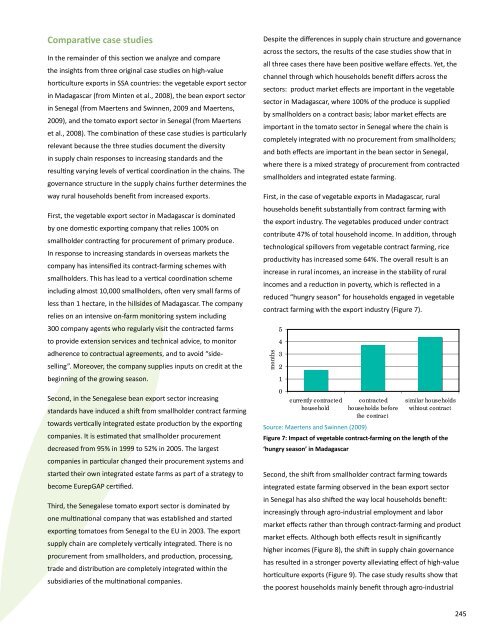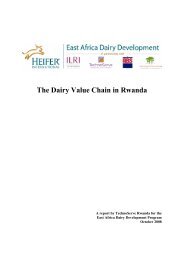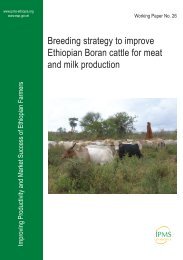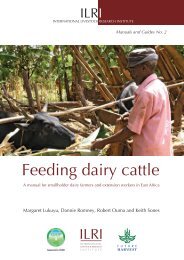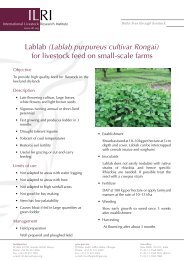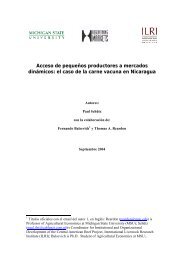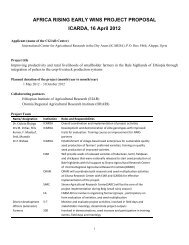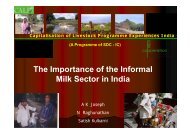High-Value Commodities and Agroprocessing - International ...
High-Value Commodities and Agroprocessing - International ...
High-Value Commodities and Agroprocessing - International ...
You also want an ePaper? Increase the reach of your titles
YUMPU automatically turns print PDFs into web optimized ePapers that Google loves.
Comparative case studies<br />
In the remainder of this section we analyze <strong>and</strong> compare<br />
the insights from three original case studies on high-value<br />
horticulture exports in SSA countries: the vegetable export sector<br />
in Madagascar (from Minten et al., 2008), the bean export sector<br />
in Senegal (from Maertens <strong>and</strong> Swinnen, 2009 <strong>and</strong> Maertens,<br />
2009), <strong>and</strong> the tomato export sector in Senegal (from Maertens<br />
et al., 2008). The combination of these case studies is particularly<br />
relevant because the three studies document the diversity<br />
in supply chain responses to increasing st<strong>and</strong>ards <strong>and</strong> the<br />
resulting varying levels of vertical coordination in the chains. The<br />
governance structure in the supply chains further determines the<br />
way rural households benefit from increased exports.<br />
First, the vegetable export sector in Madagascar is dominated<br />
by one domestic exporting company that relies 100% on<br />
smallholder contracting for procurement of primary produce.<br />
In response to increasing st<strong>and</strong>ards in overseas markets the<br />
company has intensified its contract-farming schemes with<br />
smallholders. This has lead to a vertical coordination scheme<br />
including almost 10,000 smallholders, often very small farms of<br />
less than 1 hectare, in the hillsides of Madagascar. The company<br />
relies on an intensive on-farm monitoring system including<br />
300 company agents who regularly visit the contracted farms<br />
to provide extension services <strong>and</strong> technical advice, to monitor<br />
adherence to contractual agreements, <strong>and</strong> to avoid “sideselling”.<br />
Moreover, the company supplies inputs on credit at the<br />
beginning of the growing season.<br />
Second, in the Senegalese bean export sector increasing<br />
st<strong>and</strong>ards have induced a shift from smallholder contract farming<br />
towards vertically integrated estate production by the exporting<br />
companies. It is estimated that smallholder procurement<br />
decreased from 95% in 1999 to 52% in 2005. The largest<br />
companies in particular changed their procurement systems <strong>and</strong><br />
started their own integrated estate farms as part of a strategy to<br />
become EurepGAP certified.<br />
Third, the Senegalese tomato export sector is dominated by<br />
one multinational company that was established <strong>and</strong> started<br />
exporting tomatoes from Senegal to the EU in 2003. The export<br />
supply chain are completely vertically integrated. There is no<br />
procurement from smallholders, <strong>and</strong> production, processing,<br />
trade <strong>and</strong> distribution are completely integrated within the<br />
subsidiaries of the multinational companies.<br />
Despite the differences in supply chain structure <strong>and</strong> governance<br />
across the sectors, the results of the case studies show that in<br />
all three cases there have been positive welfare effects. Yet, the<br />
channel through which households benefit differs across the<br />
sectors: product market effects are important in the vegetable<br />
sector in Madagascar, where 100% of the produce is supplied<br />
by smallholders on a contract basis; labor market effects are<br />
important in the tomato sector in Senegal where the chain is<br />
completely integrated with no procurement from smallholders;<br />
<strong>and</strong> both effects are important in the bean sector in Senegal,<br />
where there is a mixed strategy of procurement from contracted<br />
smallholders <strong>and</strong> integrated estate farming.<br />
First, in the case of vegetable exports in Madagascar, rural<br />
households benefit substantially from contract farming with<br />
the export industry. The vegetables produced under contract<br />
contribute 47% of total household income. In addition, through<br />
technological spillovers from vegetable contract farming, rice<br />
productivity has increased some 64%. The overall result is an<br />
increase in rural incomes, an increase in the stability of rural<br />
incomes <strong>and</strong> a reduction in poverty, which is reflected in a<br />
reduced “hungry season” for households engaged in vegetable<br />
contract farming with the export industry (Figure 7).<br />
months<br />
5<br />
4<br />
3<br />
2<br />
1<br />
0<br />
currently contracted<br />
household<br />
Source: Maertens <strong>and</strong> Swinnen (2009)<br />
contracted<br />
households before<br />
the contract<br />
similar households<br />
wihtout contract<br />
Figure 7: Impact of vegetable contract-farming on the length of the<br />
‘hungry season’ in Madagascar<br />
Second, the shift from smallholder contract farming towards<br />
integrated estate farming observed in the bean export sector<br />
in Senegal has also shifted the way local households benefit:<br />
increasingly through agro-industrial employment <strong>and</strong> labor<br />
market effects rather than through contract-farming <strong>and</strong> product<br />
market effects. Although both effects result in significantly<br />
higher incomes (Figure 8), the shift in supply chain governance<br />
has resulted in a stronger poverty alleviating effect of high-value<br />
horticulture exports (Figure 9). The case study results show that<br />
the poorest households mainly benefit through agro-industrial<br />
245


